Exploring the Double-Edged Sword of Artificial Intelligence

Artificial Intelligence (AI) has woven itself into the fabric of our daily lives, from enhancing user experience on smartphones to driving the development of autonomous vehicles. But as its influence grows, so too does the concern about its potential dangers.
This introduction delves into both the benefits and the risks associated with AI. It sheds light on the ethical dilemmas, potential threats, and the urgent need for comprehensive regulations to ensure that AI technologies enhance rather than endanger human society.
Understanding Artificial Intelligence
Artificial intelligence (AI) encompasses computer systems designed to mimic human intelligence. These systems can learn, reason, and make decisions. AI technology powers various useful applications, from smartphone assistants to autonomous vehicles. Its growing importance has sparked discussions about its implications, particularly its potential for danger.Understanding the full scope of AI is the first step towards assessing its risks and benefits.
The Potential Threats of AI
The concept of AI as a potential threat often centers on scenarios where machines could act unpredictably. This includes fears about AI surpassing human intelligence and acting against human interests. For instance, AI-driven warfare technology could lead to new forms of conflict that are hard to control.
Moreover, the potential misuse of AI in areas like surveillance can lead to privacy violations. The ability of AI systems to process vast amounts of data quickly could be exploited, infringing on individual freedoms.
The Ethical Challenges of AI
As AI technology advances, ethical challenges arise, particularly regarding decision-making in sectors like healthcare and criminal justice. AI systems making decisions about human lives without clear ethical guidelines pose significant risks.
The development of AI is outpacing the creation of ethical guidelines and regulations. This lag can lead to scenarios where AI’s decisions are not aligned with societal values.Addressing these challenges is crucial for integrating AI into society responsibly.
Experts argue for the establishment of robust ethical frameworks that guide AI development and implementation. These would ensure that AI actions are predictable and aligned with human ethics.
AI in the Workplace
AI’s integration into the workplace offers potential efficiency boosts but also raises concerns about job displacement. As AI takes over routine tasks, workers might need to adapt to new roles that require different skills.
This transition can create a divide between those who can adapt and those who cannot, potentially leading to significant economic disparities. It is important for educational systems to evolve alongside AI to prepare the workforce adequately.
The Future of AI Regulation
Regulating AI effectively is crucial to mitigate its risks while promoting its benefits. Governments and international bodies are beginning to discuss and implement regulations that could shape the future of AI development.
These regulations aim to protect individuals and ensure that AI is used for the benefit of society as a whole. By setting clear guidelines, authorities can help steer AI development in a direction that maximizes its positive impact while minimizing potential harms.
The Role of Public Perception
How the public perceives AI can significantly influence its development and regulation. Misconceptions and sensationalized media portrayals can lead to fear and hesitancy around AI technologies.
It is vital for accurate, balanced information about AI to be accessible to the public. This helps in forming educated opinions and constructive discussions about AI’s role in society.Ensuring a well-informed public is key to the responsible development and implementation of AI technologies.
Concluding Insights on AI Safety
While AI presents numerous opportunities, its potential dangers cannot be overlooked. Striking a balance between innovation and safety is essential.
Continued dialogue among technologists, policymakers, and the public is necessary to navigate the complexities of AI. By addressing concerns through comprehensive policies and informed public discourse, the safe integration of AI into society can be achieved.
As we scrutinize the intricate dance between innovation and safety in artificial intelligence, the conclusion is clear: the potential of AI is vast, yet so are its risks. Striking a balanced approach to AI oversight is not optional but essential for ensuring its benefits outweigh the dangers.
In the grand scheme, fostering an informed discourse surrounding AI, increasing public awareness, and enforcing robust regulations are pivotal. These steps will safeguard our shared future, integrating AI advancements responsibly into the societal fabric.








